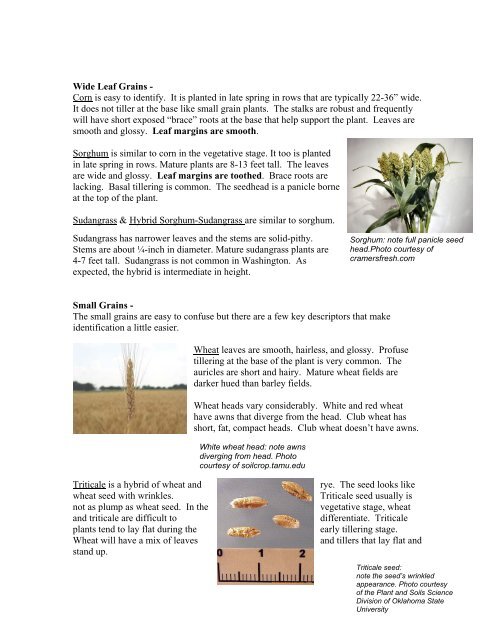Technical Note 5 - Plant Identification - Plant Materials Program - US ...
Technical Note 5 - Plant Identification - Plant Materials Program - US ...
Technical Note 5 - Plant Identification - Plant Materials Program - US ...
Create successful ePaper yourself
Turn your PDF publications into a flip-book with our unique Google optimized e-Paper software.
Wide Leaf Grains -<br />
Corn is easy to identify. It is planted in late spring in rows that are typically 22-36” wide.<br />
It does not tiller at the base like small grain plants. The stalks are robust and frequently<br />
will have short exposed “brace” roots at the base that help support the plant. Leaves are<br />
smooth and glossy. Leaf margins are smooth.<br />
Sorghum is similar to corn in the vegetative stage. It too is planted<br />
in late spring in rows. Mature plants are 8-13 feet tall. The leaves<br />
are wide and glossy. Leaf margins are toothed. Brace roots are<br />
lacking. Basal tillering is common. The seedhead is a panicle borne<br />
at the top of the plant.<br />
Sudangrass & Hybrid Sorghum-Sudangrass are similar to sorghum.<br />
Sudangrass has narrower leaves and the stems are solid-pithy.<br />
Stems are about ¼-inch in diameter. Mature sudangrass plants are<br />
4-7 feet tall. Sudangrass is not common in Washington. As<br />
expected, the hybrid is intermediate in height.<br />
Small Grains -<br />
The small grains are easy to confuse but there are a few key descriptors that make<br />
identification a little easier.<br />
Sorghum: note full panicle seed<br />
head.Photo courtesy of<br />
cramersfresh.com<br />
Wheat leaves are smooth, hairless, and glossy. Profuse<br />
tillering at the base of the plant is very common. The<br />
auricles are short and hairy. Mature wheat fields are<br />
darker hued than barley fields.<br />
Wheat heads vary considerably. White and red wheat<br />
have awns that diverge from the head. Club wheat has<br />
short, fat, compact heads. Club wheat doesn’t have awns.<br />
White wheat head: note awns<br />
diverging from head. Photo<br />
courtesy of soilcrop.tamu.edu<br />
Triticale is a hybrid of wheat and rye. The seed looks like<br />
wheat seed with wrinkles. Triticale seed usually is<br />
not as plump as wheat seed. In the vegetative stage, wheat<br />
and triticale are difficult to differentiate. Triticale<br />
plants tend to lay flat during the early tillering stage.<br />
Wheat will have a mix of leaves and tillers that lay flat and<br />
stand up.<br />
Triticale seed:<br />
note the seed’s wrinkled<br />
appearance. Photo courtesy<br />
of the <strong>Plant</strong> and Soils Science<br />
Division of Oklahoma State<br />
University

















